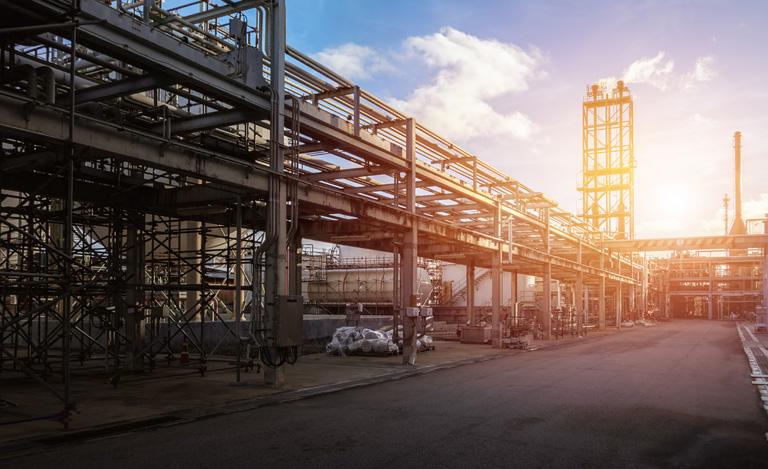In a world marked by rapid technological advancement and evolving economic landscapes, the sectors of agriculture and industry are at the forefront of innovation and sustainability.As these critical fields strive to meet the increasing demands for efficiency and productivity, the role of construction solutions becomes ever more significant. From the expansive fields of agribusiness to the intricate web of industrial operations, the need for comprehensive construction strategies is paramount. This article delves into the multifaceted construction solutions tailored specifically for agriculture and industry, exploring how they not only address current challenges but also pave the way for a resilient and sustainable future. Join us as we uncover the innovative techniques, materials, and practices shaping the built surroundings for these vital sectors, bridging the gap between conventional methods and modern demands.
Innovative Materials Transforming Agricultural Infrastructure
The landscape of agricultural infrastructure is undergoing a remarkable conversion, driven by innovative materials that offer enhanced durability, sustainability, and efficiency. These materials are not just a trend; they represent a pivotal shift towards optimizing agricultural production and enhancing the resilience of farming operations.
One of the most promising innovations is biocomposites, which blend natural fibers and biodegradable resins to create sustainable building products. These materials are lightweight yet strong, making them ideal for constructing facilities like barns, greenhouses, and storage units. By utilizing locally sourced fibers, farmers can reduce their carbon footprint while also supporting local economies.
- Recycled Plastics: Repurposed plastic materials are being molded into durable components for irrigation systems and protective structures. This not only diverts waste from landfills but also offers long-lasting solutions against the elements.
- smart Concrete: Incorporating technology into concrete, such as self-healing agents and thermal-reflective additives, allows for longer-lasting infrastructure that adapts to environmental conditions, thus maximizing operational uptime.
- Geopolymer Materials: Created from industrial by-products, these materials serve as a sustainable alternative to traditional cements, reducing greenhouse gas emissions during production.
A practical application of innovative materials can be seen in greenhouse construction. High-performance films and insulated panels made from advanced polymers not only enhance light transmission but also improve thermal regulation, which is crucial for plant growth. When paired with automated systems made of these materials, farmers can create controlled environments that significantly boost crop yields.
| Material Type | Benefits | Application |
|---|---|---|
| Biocomposites | Eco-pleasant, Durable | Barns, Greenhouses |
| Recycled Plastics | waste Reduction, Long-lasting | Irrigation Systems |
| Smart Concrete | Resilience, Uptime | Storage Facilities |
| Geopolymers | Sustainability, Reduced emissions | Foundation Works |
The integration of these advanced materials not only enhances the performance and longevity of agricultural structures but also aligns with the growing demand for sustainable practices in farming. As the industry continues to innovate, the incorporation of these materials will play an essential role in creating resilient agricultural infrastructure capable of withstanding the challenges posed by climate change and increasing food production demands.
Integrating technology for Enhanced Efficiency in Industrial Construction
In the fast-evolving field of industrial construction, the integration of technology plays a pivotal role in streamlining processes and enhancing overall efficiency. By embracing innovative solutions, companies can not only reduce costs but also improve project timelines and boost collaboration among teams. Here are a few key technologies revolutionizing the industry:
- Building Details Modeling (BIM): This digital representation of a project enables seamless collaboration among various stakeholders. BIM allows for real-time updates and efficient communication, significantly reducing discrepancies and rework.
- Artificial Intelligence (AI): AI algorithms can analyze vast datasets to predict potential project challenges and optimize construction schedules. This predictive analysis helps in risk management and ensures timely decision-making.
- Robotics and Automation: Automated machinery and robotic systems improve precision and speed on-site, handling repetitive tasks with greater accuracy and freeing human labor for more complex responsibilities.
- IoT Sensors: Integrating Internet of Things (IoT) technology allows for real-time monitoring of equipment and materials, enhancing inventory management and reducing waste through more informed decision-making.
The implementation of these technologies not only enhances efficiency but also contributes to improved safety and sustainability in construction projects. For instance, drones can swiftly survey sites and deliver vital real-time data, helping to identify hazards early and reduce on-site accidents. Moreover, energy-efficient equipment powered by the latest tech reduces the environmental impact, aligning construction practices with sustainable advancement goals.
| Technology | Benefits |
|---|---|
| BIM | Enhances collaboration, reduces errors |
| AI | Predicts issues, improves resource allocation |
| Robotics | Increases precision, handles repetitive tasks |
| IoT Sensors | Continuous monitoring, reduces waste |
Additionally, workforce productivity is greatly enhanced by the use of mobile technologies. Apps designed specifically for construction management allow teams to update their progress in real-time while on-site, ensuring everyone is on the same page.These applications bridge the gap between the office and the field, enabling quick information sharing, which is crucial in keeping projects on track.
Incorporating these technologies into industrial construction practices creates a foundation for long-term growth and resilience. The ability to adapt and innovate with the latest advancements positions companies to meet evolving market demands and develop robust solutions for today’s challenges.
Sustainable Practices in Construction: Reducing Environmental Impact
In the construction industry, adopting sustainable practices is not just a trend, but a necessity. By prioritizing environmentally friendly methods, builders can significantly lower their carbon footprint and promote the health of our planet. Here are several approaches that focus on minimizing environmental impacts:
- Material Selection: Opt for recycled or locally sourced materials to reduce transportation emissions and support local economies.
- Energy Efficiency: Implement energy-efficient designs and technologies, such as solar panels and high-efficiency HVAC systems, to lower energy consumption.
- Waste Management: Develop comprehensive waste reduction plans that emphasize recycling and reusing materials during the construction process.
- Water Conservation: utilize water-efficient fixtures and implement rainwater harvesting systems to minimize water usage on site.
Integrating renewable energy solutions not only decreases reliance on fossil fuels but also reduces operating costs in the long run. As an example, installing solar energy systems can transform a construction project into a self-sustaining endeavor, enabling buildings to generate their own power. Additionally, the usage of wind turbines can provide further supplementary energy, especially in agricultural settings where space is frequently enough vast.
Green Certifications have gained traction in the construction sector, encouraging firms to adhere to elevated environmental standards. Certifications such as LEED (leadership in Energy and Environmental Design) and BREEAM (Building Research Establishment Environmental Assessment Method) recognize sustainable building practices. here is a simple comparison table showcasing these certifications:
| Certification | Focus Area | Global Reach |
|---|---|---|
| LEED | Energy efficiency, water usage, materials | Worldwide |
| BREEAM | Environmental performance, health & wellbeing | Primarily UK, but expanding |
adopting a holistic approach to site management can vastly enhance sustainability outcomes. This involves planning construction schedules to mitigate emissions during peak times, employing sustainable transport options for staff and materials, and conducting regular environmental impact assessments throughout the project duration. Innovative technologies such as Building Information Modeling (BIM) can further aid in visualizing and optimizing resources, resulting in less waste and more efficient construction timelines.
Tailored Solutions for Diverse Agricultural Needs
By understanding the complexities of different agricultural practices, we aim to provide:
- Custom-Built Facilities: We design and construct specialized barns, greenhouses, and silos that enhance efficiency while maximizing safety and functionality.
- Storage Solutions: Tailored storage systems for grains, seeds, and fertilizers help ensure optimal product preservation and accessibility, minimizing wastage.
- Livestock Housing: constructed with animal welfare in mind, our livestock facilities promote health and growth, equipped with modern ventilation and feeding systems.
- Processing Facilities: From fruit packing to dairy processing, our facilities are designed to streamline operations and adhere to regulatory standards.
In the face of climate change and evolving market demands, adaptability is key. Our modular designs allow for easy expansion and adaptation based on the shifting needs of your operation. This approach not only saves time on construction but also reduces costs in the long run, ensuring that your investment grows with your business.
To illustrate the impact of our solutions, consider the following advantages of our tailored construction offerings:
| Feature | Benefit |
|---|---|
| Energy-Efficient Designs | Lower operational costs and reduced environmental impact. |
| Advanced Irrigation Systems | Optimized water usage and improved crop yield. |
| Integrated Technology Solutions | Real-time monitoring and management for enhanced productivity. |
Our collaboration with local agricultural experts ensures that each project is informed by the latest industry insights. This partnership approach allows us to craft solutions that not only meet immediate needs but also anticipate future challenges, providing a competitive edge in the fast-paced agricultural landscape.
we pride ourselves on our ability to listen and adapt to the specific needs of each client, creating unique construction solutions that foster growth and sustainability within the agricultural sector. Together, we can build a brighter future for farmers and agribusinesses, one tailored solution at a time.
safety Standards and Best Practices in Construction for Industry
- Risk Assessment: Conduct thorough risk assessments prior to any project. Identifying potential hazards early ensures that necessary precautions can be implemented.
- Personal Protective Equipment (PPE): Equip all workers with appropriate PPE tailored to their tasks, including helmets, gloves, and high-visibility clothing.
- site Induction: All personnel should undergo site-specific induction which includes safety protocols, emergency procedures, and equipment operations.
- Regular Training: Ongoing training sessions should be mandatory to keep everyone updated on new safety practices and emerging risks.
- Emergency Preparedness: Develop and communicate emergency action plans, ensuring everyone knows their role in a crisis situation.
Furthermore, the effective implementation of safety protocols significantly reduces the risk of accidents on construction sites. A pivotal aspect of this is the establishment of a strong safety culture, where workers feel empowered to report unsafe behaviors without fear of repercussion.As a notable example, introducing a peer safety observation program can cultivate a sense of shared responsibility among the workforce.
Notably, integrating technological tools can enhance safety monitoring and compliance efforts. For example, using drones for site inspections can definitely help identify hazards without putting personnel at risk.Wearable technology can also track workers’ vital signs and environmental conditions, alerting supervisors to potential health issues before they escalate.
The following table outlines a comparison of traditional safety approaches versus modern enhancements:
| Traditional Approach | Modern Enhancement |
|---|---|
| Manual safety checks | Automated monitoring systems |
| Periodic training sessions | Continuous learning platforms |
| Paper-based incident reports | Real-time reporting apps |
| Generic PPE provision | Customized PPE based on tasks |
Lastly, regular audits and feedback loops are essential.Establishing a framework for evaluation ensures that safety measures are not only in place but also effective. Routinely soliciting input from employees on safety practices can lead to innovative solutions and a more engaged workforce. this collective effort towards safety is crucial in minimizing risks and achieving high standards across the construction industry.
Future Trends in Construction Solutions for Agriculture and Industry
One of the significant trends is the integration of smart technologies into construction practices. The use of IoT (Internet of Things) devices is transforming how facilities monitor and manage resources. As a notable example, sensors can optimize water usage in agricultural settings, while industrial sites can automate machinery to enhance productivity. This level of integration leads to:
- Real-time data collection for proactive decision-making.
- Predictive maintenance that minimizes downtime.
- Energy efficiency through smart grid technologies.
Additionally, the trend towards sustainable building materials is gaining momentum. Construction solutions are increasingly favoring materials that are not only durable but also reduce carbon footprints. Options include:
- Bamboo: A rapidly renewable resource with high strength-to-weight ratio.
- Recycled steel: Contributes to less waste and lower energy consumption during production.
- Insulated concrete forms: Improve energy efficiency and reduce heating/cooling costs.
The rise of modular construction is another pivotal trend, particularly in agricultural and industrial setups. This method allows for prefabrication of building components in controlled factory environments, which then get transported to the site for assembly. The benefits here include:
- Reduced construction time due to efficient assembly processes.
- Less material waste, as components are created using precision manufacturing.
- Flexibility in design and potential for easy expansion or reconfiguration.
Lastly, the advancement of drones and robotics in construction is revolutionizing surveying and monitoring processes. Drones provide aerial views for land assessments, while robotics can manage repetitive tasks. these technologies not only enhance accuracy but also improve safety by reducing human involvement in hazardous conditions. The table below summarizes the applications:
| Technology | Application | benefits |
|---|---|---|
| Drones | Land surveying and monitoring | High-resolution visuals, fast data collection |
| Robotics | Automated installation and assembly | Improved precision and safety |
As these trends continue to unfold, the intersection of construction, agriculture, and industry is set to redefine operational efficiency and sustainability. By adopting these innovative solutions, stakeholders not only address current challenges but also contribute to a sustainable future with responsible resource management.
To Conclude
As we navigate an evolving landscape marked by both agronomic challenges and industrial demands, comprehensive construction solutions emerge as pivotal players in shaping a sustainable future. By integrating innovative design, advanced technology, and a deep understanding of sector-specific needs, these solutions not only enhance operational efficiency but also foster resilience against the uncertainties of tomorrow.
In the realm of agriculture, where the balance between productivity and environmental stewardship is paramount, and within industries driven by rapid advancements and shifting markets, the construction strategies we adopt today will define the parameters of success. It is through collaboration, adaptability, and a commitment to excellence that we can build the infrastructure necessary to support our evolving landscape.
In closing, as we build bridges—both literal and metaphorical—between agriculture and industry, let us embrace a holistic approach that values vision, functionality, and sustainability. Together, we can cultivate a future where both sectors flourish, underpinning economic growth and promoting a harmonious coexistence with the environment. The path ahead is bright, and it beckons us to invest in the solutions that will withstand the test of time.







